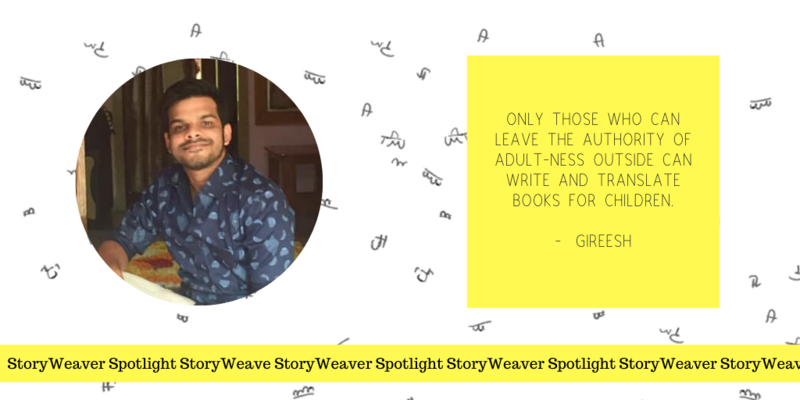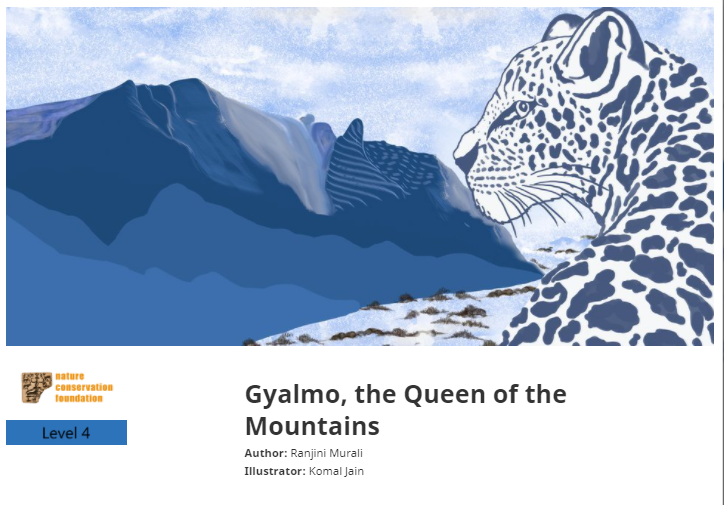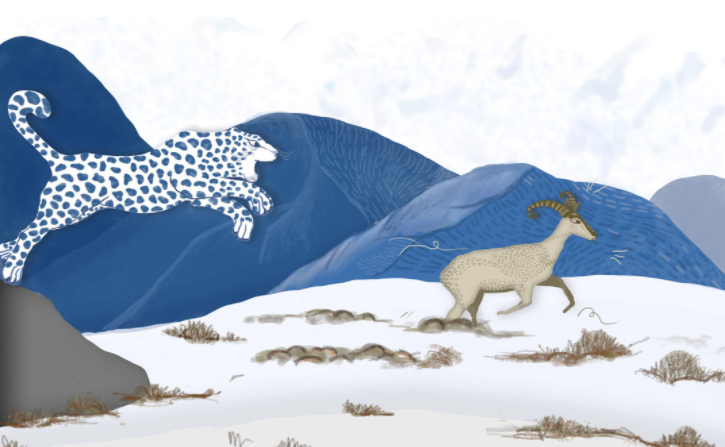On translating children's books: A Google Serve volunteer's story
Posted by Remya Padmadas on January 06, 2020Karthigeyan Sivaraj is a Google Serve campaign volunteer who has worked with StoryWeaver to help translate several storybooks into Tamil, including I Can Climb! and My Best Friend.
In this Q&A, Karthigeyan shares his experience about translating on StoryWeaver, his insight into the translation process, and his love for children's literature.

Q: Do tell us a little bit about yourself, your interests, your work
I'm a Googler by profession and by practice, and I'm proud of that! At work, being a Googler means respecting my colleagues and welcoming their opinions and ideas, howsoever different they may be to my own, and keeping things necessarily simple to my stakeholders, and I attempt to do the same outside the walls of my office as well. Having learned how to analyze data on the job, I brand myself as a data story-teller - i.e., processing data and presenting meaningful information in a way that pushes the audience to take the desired action. The interesting aspect of my job is that it allows me to improve the existing processes through imaginative ways and take ownership of some of the workflows in my organisation, thereby ensuring candidates joining Google have a lasting positive impression about their onboarding experience.
Q: Do you remember the first time you heard about StoryWeaver? What are your thoughts about the platform?
Of course, it's quite vivid in my memory the first time I heard about StoryWeaver. The concept of weaving children's stories is quite dear to my heart, and it's really gladdening to see the team working behind crafting stories as well as making them available in multiple different languages for the young audience to read and relish. I personally nurtured a similar idea a few years ago when I was an avid blogger but didn't have the imaginative power nor the enterprising capabilities to venture into this domain - I was really happy to find the StoryWeaver team doing some marvellous work in this field. Kudos to all!
Q: What was your experience of the GServe campaign, and translating books with fellow Google volunteers?
It's always a very humbling experience to take part in any GServe campaign, no matter what the cause that's being championed. The StoryWeaver campaign was very well thought through in many ways - for one, it didn't require us to sacrifice the luxury of our desks and we could contribute while at work or on the move. It was also so much fluid socializing with fellow Googlers who were taking up similar translation work. Overall, it was a rewarding experience to be able to contribute our might in little ways possible to make a huge change!
Q: We are so glad that you came on board as a commissioned translator even after the GServe campaign! What prompted you to stay in touch?
As I had mentioned previously, contributing to children's literature was always dear to me, and when I got to know about StoryWeaver's mission and their robust infrastructure, I felt relieved knowing that I didn't have to worry too much about the modus operandi, but rather focus on the work itself. With a major piece of work shouldered by the StoryWeaver team, I wanted to work with the team even after the GServe campaign, so that I could do what I like to do - writing, crafting and translating.
Q: What was your experience of being a commissioned translator? Did you pick up any new tips and techniques?
A lot I must say! One very important technique I adopted pretty early on was that I realized that translating the original work into the language of my preference required knowing the cultural nuances deeply. For instance, while translating a story from English targeting the Hindi speaking audience and translating it into Tamil would mean we will have to take into account the various cultural aspects such as the equivalent idioms used in the region. Internalizing all these cultural & regional nuances in the local language while translating is imperative if the audience has to relate to the stories. Else, they wouldn't 'stick'!
Q: How tricky is it to translate stories to Tamil? Are there any phrases that you particularly spent time on because they were difficult to translate?
Tamil, for all its richness, is a very unique language in that there are several different dialects in use across the Tamil diaspora. It becomes even trickier when you realize that the written form of the language is very different to the conversational style, and even the conversational style assumes a different shade when it comes to young audiences. Stories will have to be narrated to children in a style that's neither too formal nor too conversational and we should be ready to use a few English words that are in daily use, so they can relate to them. Also, unfortunately, tools such as Google Translate provide very literal translations of phrases which is sometimes very challenging even to the mature audience, hence you have to take a judgement call based on your own intuition and observation. I bet this is true for many Indic languages!
Q: What has been your favourite book to translate on StoryWeaver?
That's a tough one! Each of the books takes you down memory lane and makes you relive your childhood :) Be it Rani's First Day at School or the restless lad who couldn't wait to open this birthday gifts the next day or the fearless little girl - each provides a glimpse of your own childhood. For the sake of picking one, I would go for I Can Climb! which is packed with a lot of positive self-talk for young kids who are taking baby steps as they encounter different activities for the very first time in their lives.

Q: What are some of your favourite books from childhood? Is there any memorable reading moment that you would like to share?
I relished reading across different genres in both English and Tamil. In Tamil literature, especially that was taught to us in school, all messages were delivered in a cryptic fashion replete with metaphors and similes. That allowed for deep learning, situational paraphrasing and lateral thinking. For that very same reason, I preferred the works of John Milton, Rudyard Kipling & John Keats in English and innumerable poets in Tamil.
As a kid, I was an avid read of Tinkle Kids' magazines, and I used to eagerly await the next monthly edition. I am really glad to see that same level of curiosity now possessed by my niece. It seems the magazine hasn't lost its attractiveness to date!
Q: The translations you have contributed to our platform have been read over 1800 times - thank you! How has your StoryWeaver journey been? What is one big takeaway from this experience?
The biggest takeaway for me has been that we shouldn't shy away from walking in the little shoes of our young audience to truly understand what holds their curiosity and interest. Many a time, we - adult learners - tend to wear our own caps, and view children's literature in a rather lop-sided manner. However, we should be ready to speak the language of the kids (sometimes even practise prattling), simplify the language (without over-simplifying at the cost of losing the essence) to suit them and be more imaginative (what helped me to feel the pulse of the audience was to subject my work to, what I like to call, the 'niece'-test - i.e., talking to my nieces and having them vet some of my initial works)
Do leave your thoughts in the comments section below. You can also reach out to us through our social media channels: Facebook, Twitter and Instagram.
Be the first to comment.StoryWeaver Spotlight: Gireesh
Posted by Pallavi Kamath on April 07, 2020Gireesh is a writer, visual artist and translator from Chennai. A fine arts graduate, his book was published last year in Tamil and an English translation is under progress. He has translated many storybooks on StoryWeaver including Friends Under the Summer Sun and Who Stole Bhaiya's Smile?

Q: Can you tell us anything about yourself and your job that would surprise us?
நான் ஓவியக்கல்லூரியில் படித்து விளம்பரத்துறையில் வேலை செய்கிறேன். விடுபட்டவை எனும் புத்தகமும் எழுதி இருக்கிறேன். பத்திரிக்கைகளுக்கு கட்டுரைகளும் கதைகளும் எழுதும் பழக்கமுண்டு.
I am an arts graduate from the Fine Arts college, working now in advertising. I have written a book called Vidupattavai, among other stories and articles.
Q: What is your personal relationship to language and/or translation?
எனக்கு புத்தகங்கள் வாசிப்பது மிகவும் பிடிக்கும். வாசிப்பதன் மூலமாக புதிது புதிதான வார்த்தைகளையும் சொல்லாடல்களையும் கண்டுகொள்ள முடிகிறது.
I love reading. I find new words and expression through reading.
Q: When you have been given a story to translate, what is your process, and how long does it usually take?
முதலில் அந்த கதையை முழுவதுமாக வாசிப்பேன். மொழிபெயர்ப்பதற்கு முன்னால் அந்தக் கதையை மனதிற்குள் பலமுறை தமிழில் சொல்லிப்பார்ப்பேன். பின்னர் அதை மொழிபெயர்ப்பு செய்வேன். மொழிபெயர்க்க இரண்டு முதல் மூன்று மணிநேரங்கள் எடுத்தாலும் குறிப்பிட்ட இடைவெளியில் அதை வாசிப்பேன். தேவைப்படும் மாற்றங்கள் செய்வேன். வாசிக்கும்போது கடினமாக இருக்கும் வார்த்தைகளையும், பெரிய பெரிய வாக்கியங்களையும் கூடுதல் கவனத்தோடு மாற்றுவேன்.
I read a story and tell it to myself in Tamil a few times. I spend a few hours translating it, and I read it a couple of times at regular intervals to make changes. When I feel certain words or sentences are hard, I change them with extra care.
Q: How did you cultivate the skills needed to translate books for children?
குழந்தைகளுக்கான புத்தகங்களை மொழிபெயர்க்க தொடங்கியபிறகு நிறைய குழந்தைகள் புத்தகம் வாசிக்கிறேன். பெரும்பாலான புத்தகங்கள் பெரியவர்கள் மொழியிலேயே இருப்பதால் வார்த்தைகளுக்கான மாற்று வார்த்தைகளைத் தேடிக் கண்டுபிடிக்கிறேன். எளிதான வார்த்தைப் பதங்களை தொடர் வாசிப்பில் இருந்தே பெற முடிகிறது.
I've read a lot of children's books since I started translating books for kids. Since most books are for adults, I look for alternative words for words. You can get easy word phrases from a series of readings.
Q: What was the experience of translating a children’s book like, compared to translating/writing for adults?
பெரியவராக இருப்பதால் பெரியவர்களின் மொழி புரிந்து விடுகிறது. ஆனால் குழந்தைகளின் மொழியைப் புரிந்து அவர்களுக்கான மொழிபெயர்ப்பு செய்வது என்பது சவாலாகவே இருக்கிறது. சமயங்களில் இது குழந்தைகளுக்கு புரியாது என இன்னும் எளிமைப்படுத்தும் விதத்தில் எழுத முயற்சிக்கும் வார்த்தைகள் குழந்தைகள் ஏற்கனவே அறிந்து வைத்திருப்பது ஆச்சரியமாக இருக்கிறது. மேலும் குழந்தைகள் புத்தகம் என்றாலும் நான்கு நிலைகளில் உள்ள குழந்தைகளிடம் கொண்டு சேர்ப்பதும் சவாலான வேலையே.
As an adult it is easy to understand adults’ language. But to understand and translate in a child's language is hard. Sometimes when I try to simplify words thinking it might not be understood by children, it was surprising to know children already knew those words. It is also challenging to work across four different levels.
Q: You have translated more than a few books for us now. Which is your favorite among them and why?
நான் மொழிபெயர்ப்பு செய்த கதைகளில் எனக்கு மிகவும் பிடித்தது கோடைகால நண்பர்கள். குழந்தைகளிடம் பாலினம் குறித்த மிகத்தேவையான உரையாடலையும், சகமனிதர்களை அவர்களாகவே ஏற்றுக்கொள்ள வேண்டும் என்கிற கருத்தையும் அந்தக் கதை கூறியதால் எனக்கு அது பிடித்திருந்தது.
Friends Under the Summer Sun was my favorite. As it starts the necessary discussion about gender, and tells every kid to accept others as they are, I like it.

Q: What is the hardest thing about translating from English into Tamil? How do you navigate words or phrases that are tricky to translate?
பெயர்களையும் ஊரையும் மொழிபெயர்ப்பில் கொண்டுவருவதே சிரமமாக இருக்கும். சில சமயம் ஒரு நல்ல கதையை மொழி பெயர்க்கும்போது நம்மால் பொருத்திப்பார்க்க முடியாத பெயர்கள் இருக்கும்போது அவற்றுடன் தொடர்புபடுத்த முடியாது. அம்மாதிரியான சமயங்களில் வாய்ப்பிருந்தால் அர்த்தம் மாறாத மற்றும் தொடர்புபடுத்தக் கூடிய பெயர்களை உபயோகிக்கிறேன். பின்னர் உணர்வுகளை வெளிப்படுத்த பயன்படும் எந்த பொருளும் இல்லாத சத்தங்களும் கடினமே. அவற்றிற்கு இணையாக தமிழில் பயன்படுத்தப்படும் சத்தங்களை அந்த இடத்தில் பயன்படுத்துகிறேன்.
It is hard sometimes to capture names of persons and places. In such situations, I make them sound more relatable. Onomatopoeia is always a challenge, I try not to transliterate and use sounds more relatable to Tamil readers.
Q: What type of person do you think makes the best translator for children’s stories?
குழந்தைகள் உலகத்துக்குள் பெரியவர்கள் எனும் அடையாளத்தோடும், அதிகாரத்தோடும் நுழையாத ஒருவரால் மட்டுமே குழந்தைகளுக்கான புத்தகத்தை எழுதவும் மொழிபெயர்க்கவும் முடியும்.
Only those who can leave the authority of adult-ness outside can write and translate books for children.
Q: Do you have any advice for anyone interested in becoming a translator?
நமது திறமையையோ நமது மொழிப்புலமையையோ குழந்தைகளுக்கு நிரூபிப்பது நமது வேலையல்ல. ஏற்கனவே எழுதப்பட்ட புத்தகத்தை சுவையும் கருத்தும் மாறாமல் எளிமையாக நமது மொழியில் மாற்றிக் கடத்துவது மட்டுமே நமது வேலை என்பதைப் புரிந்துகொள்பவராலேயே ஒரு நல்ல மொழிபெயர்ப்பை செய்ய முடியும்.
We are not trying to impress children with our talent and language skills. We only transfer a book with the same feel and simplicity. One can be a good translator when one understands this.
You can read all the books translated by Gireesh here.
Do join the conversation by leaving your thoughts in the comments section below. You can also reach out to us through our social media channels: Facebook, Twitter and Instagram.
comment (1)#WorldWildlifeDay: A conversation with the author of 'Gyalmo, the Queen of the Mountains'
Posted by Pallavi Kamath on March 04, 2021We are delighted to host books published by the Nature Conservation Foundation, and make them available for free under the CC BY 4.0 license on StoryWeaver. We hope that our community will enjoy reading & learning more about India's wildlfe through these stories, and that they will be translated into many more languages. The first 2 books resulting through this partnership are Gyalmo, the Queen of the Mountains and Birds That Sing Their Name.
In this post, we'll give you a closer look at the making of 'Gyalmo, Queen of the Mountains'!
About the book: Koyna and her friend Lobzang are in Spiti Valley, trying to spot the most elusive cat in the world, while Gyalmo, the snow leopard, watches from a distance as they try their best to see her. Written by Ranjini Murali and illustrated by Komal Jain.

Ranjini Murali, the author, is the Conservation Scientist at the Snow Leopard Trust. In this interview, she tells us about her fascination with the mountains and why she wrote a children's book about snow leopards.
Tell us why you chose to write about the mountains?
This story was first written for the 'Hindu in School' newspaper supplement which was meant for children studying in Bangalore and Chennai. I wrote this story then, as I wanted to introduce children to the fascinating animals of the Trans-Himalaya.
What is the message that you hope to share through these stories?
When I was a student in Bangalore, I didn't know there were snow leopards in India, nor did I know of these stunning landscapes or the amazing biodiversity present here. Maybe children now are more aware of this, but through this story, I hope to bring a bit more awareness to these landscapes.

Illustration by Komal Jain
What inspired you to conceptualize this story?
I've worked in the Trans-Himalaya for more than 10 years now and have never really seen a snow leopard! Part of this story was inspired by my constant search to see the snow leopard. The chase sequence was inspired by an video I had seen online of a snow leopard chasing a bharal!

Illustration by Komal Jain
How did you get to know about StoryWeaver, and what prompted you to make your story available on our platform?
I knew of the amazing work that StoryWeaver was doing, making reading accessible to children everywhere, so I jumped at the opportunity when a colleague reached out to me about plans of creating books on the platform. I especially love how the stories on the platform are accompanied by amazing illustrations. I was so excited to see this story come alive through the illustrations! I also like that the stories are available to be translated, so they are accessible to more children around India.
Read Gyalmo, the Queen of the Mountains